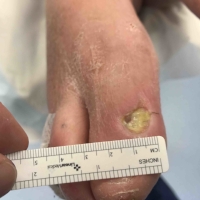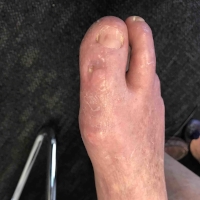What is a Diabetic Foot Ulcer?
A diabetic foot ulcer is a wound or an open sore and is usually located at the bottom of the foot. Even small ulcers or injuries may be slow to heal in people with diabetes, so early treatment is always the best option to avoid complications.
Patients with diabetes are at risk of developing multiple complications including damage to nerves and poor circulation, which put feet at risk of harm or injury. This is more likely if:
- You have had diabetes for a long time
- You have elevated blood glucose levels for an extended period
- You smoke
- You are inactive
Low risk: Feet have normal sensation and good blood flow. However, regular checks are important as feet can become high risk without symptoms.
High risk: Patients with previous ulcers or amputations, feet with calluses or deformities such as claw toes and if poor feeling and/or decreased blood flow are present.
Nerve damage (neuropathy) is a complication of diabetes that leads to a loss of sensation in the feet. Pain is no longer perceived due to numbness and injury may go unnoticed.
Diabetes can also cause damage to blood vessels, decreasing the blood flow to the feet. Poor circulation weakens bone structure, resulting in disintegration of the foot and ankle bones and joints. As a result, diabetics are at an increased risk of fractures in the foot. If a fracture occurs, the patient may not be aware of nerve damage and continued walking may result in more severe fractures and joint dislocations.
Patients with diabetes are at risk of developing multiple complications including damage to nerves and poor circulation, which put feet at risk of harm or injury. This is more likely if:
- You have had diabetes for a long time
- You have elevated blood glucose levels for an extended period
- You smoke
- You are inactive
Low risk: Feet have normal sensation and good blood flow. However, regular checks are important as feet can become high risk without symptoms.
High risk: Patients with previous ulcers or amputations, feet with calluses or deformities such as claw toes and if poor feeling and/or decreased blood flow are present.
Nerve damage (neuropathy) is a complication of diabetes that leads to a loss of sensation in the feet. Pain is no longer perceived due to numbness and injury may go unnoticed.
Diabetes can also cause damage to blood vessels, decreasing the blood flow to the feet. Poor circulation weakens bone structure, resulting in disintegration of the foot and ankle bones and joints. As a result, diabetics are at an increased risk of fractures in the foot. If a fracture occurs, the patient may not be aware of nerve damage and continued walking may result in more severe fractures and joint dislocations.
DIABETIC FOOT PROBLEMS
The most common causes of hospitalisation in diabetic patients are ulcerations, infections, and gangrene ((Ingrid Kruse, 2006). Diabetic ulcers go hand in hand with neuropathy; patients often feel numbness or no pain at all in the ulcer area. Ulcers require constant management due to complications that can arise from loss of blood flow, lack of sensation and slow healing. Proper management can reduce the risk of amputation.
Diabetics often have trouble healing after surgery due to their fluctuating insulin levels. For this reason, minimally invasive surgical techniques (requiring smaller incisions) are often the best option and the results may be profound.
FOOT COMPLICATIONS ASSOCIATED WITH DIABETES
Foot complications account for more hospital admissions than any other diabetic problem. The two major complications are foot ulcers and amputations.
Ulcers. It is usually a combination of problems rather than a single risk factors that causes ulceration. These include peripheral neuropathy (nerve damage), peripheral vascular disease, foot deformities (clawing toes), external trauma and peripheral oedema. The most common trauma in Western countries is inappropriate footwear.
Patients with diabetes are at risk of developing multiple complications including damage to nerves and poor circulation. These complications make your feet at risk for harm or injury and is more likely to occur if:
- You have had diabetes for a long time
- Your blood glucose levels have been too high for an extended period
- You smoke
- You are inactive
Low risk feet: Have normal sensation and good blood flow. However it is important to know that low risk feet can become high risk feet without symptoms, so regular checks are still important.
High risk feet: Are those people who have had a foot ulcer or amputation in the past. Feet with calluses or deformities like claw toes also have increased risk, if poor feeling and/or decreased blood flow are also present.
Nerve damage (neuropathy) is a complication of diabetes that leads to a loss of sensation in the feet. When the nerve is damaged it no longer perceives pain due to numbness and therefore does not warn of injury. This is particularly true in the foot.
Diabetes can also cause damaged blood vessels, decreasing the blood flow to the feet. Poor circulation weakens bone causing disintegration of the bones and joints in the foot and ankle. As a result, people with diabetes are at a high risk for bones fractures in the foot.
When a diabetic fractures a bone in the foot, they may not be aware due to nerve damage. Continuing to walk on the injured foot results in more severe fractures and joint dislocations.



